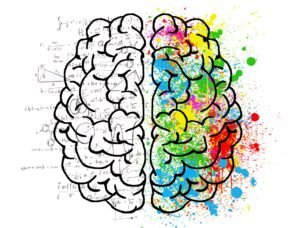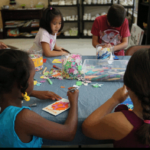It is important that your child is ready for kindergarten. However, you cannot afford preschool; and most people can’t afford sending their child to preschool at $24,000 per year, per child. You make too much money to put your child in a free program, but not enough money to afford it yourself. What can you do?
Above all, parents should be involved in their child’s lives in order to build healthy relationships as a foundation and reference point for all things they do moving forward. With a healthy relationship, parents can begin building their child’s cognitive, social, emotional, speech, and language development, gross motor and fine motor skills. With these skills and developments in place, children can begin branching into science, technology, arts, and other technical fields.
Fundamentals
There are many ways parents can prepare their child for kindergarten when they can’t afford preschool. Like in any field, you must start with the building blocks. Your child can’t learn what 2+2 means until you first teach them the meaning of 2 and 4. Everything your child does for the next 20+ years of learning starts now and you are responsible for it. Here is how you can build a solid foundation for your child.
Parent Involvement – Be the Teacher When You Can’t Afford Preschool
The first and most important way to prepare your child is to be actively involved in your child’s life. this is especially true when you can’t afford to send your child to preschool. Building a healthy and positive relationship with your child sets the foundation for what a healthy relationship looks like for the rest of their lives. All relationships are full of ups and downs, positives and negatives, pain and joy. Make sure you go through these peaks and valleys with your child and not only teach by example, but also by explaining why things happen.
Reinforcements: Teaching Positive and Negative Consequences
Consequence? When you hear of the word consequence, the first thing that pops in your mind is something negative. Partially, you are correct. Believe it or not, there is a thing called positive consequences alongside negative consequences. A positive consequence is when your child does something you have asked or expected. In return, you immediately reward things your child loves and enjoys. In doing so, the positive consequence or reward will increase the likelihood of your child completing your expectations and producing the positive or desired behaviors.
Positive Reinforcements Versus Bribes
How are positive consequences different from bribing? You may think positive consequences sound a lot like bribing. In your mind, you tell a child to complete a task and a reward will be given, right? Well, positive reinforcement is when the behavior outcome is immediately followed by a reward. Bribery occurs when you offer the reward once your child displays a negative behavior.
Positive Reinforcement Example
Parent: Johnny, please clean up your room. When you are done, you can have chocolate ice cream.
Johnny: *Cleans up his room*
Parent: Great job, Johnny. Here is your chocolate ice cream.
Bribery Example
Parent: Johnny, please clean up your room.
Johnny: NO *runs away and screams*
Parent: Johnny, if you clean your room, you can have a chocolate ice cream.
Johnny: *Cleans up his room*
Parent: Great job, Johnny. Here is your chocolate ice cream.
The difference between these two examples is that the parent offers Johnny a reward when he was defiant and refused to clean his room. Johnny was basically rewarded for having a bad behavior with an ice cream. This is bribery.
So what do you do when your child refuses to do what you ask them on your first try? Firstly, make sure the (desirable) reward is part of your first request. When your child refuses, make sure to repeat the request a couple times along with the original reward. Do not change the reward, and do not give up! If your child never fulfills your request, you have two options:
- Nothing happens, and your child does not receive their reward.
- Nothing happens, and you begin negative consequences, such as taking away play time
Negative Reinforcements
On the other hand, a negative consequence is when you give punishment to your child for displaying a negative behavior. This will generally increase the probability of your child meeting your expectations and therefore increasing positive behavior. Remember to take into consideration your child’s age and capabilities and to not go overboard with your punishments.
Skills Development
You need to be aware of your child’s learning abilities along with their skills. Below are the five main areas of development and what you can do to help your child develop and be ready for school!
Cognitive Development
Your child needs to be able to solve problems. Read a book and ask questions to your child. Have your child predict what will happen in the story and ask them why. You can also ask your child why something happened in the story. Other questions include:
- How they feel about the story
- What would they do differently in the story
- Who is their favorite character and why

Math Skills
Math for young children primarily consists of knowing numbers, counting, sorting and grouping.
You can teach your child math skills while eating or playing. This can be time consuming but the overall outcome is worth it. During snack time, have your child count every goldfish you place on the plate. This allows for number sense being able to rote count. When your child eats a couple here and there, ask your child to count to see how many are left on the plate. This allows for subtraction. You can do the same for addition.
You can also ask questions relating to the sizes, colors, and shapes if the items allow for it. When there are four people for lunch, ask your child how many plates, cups, forks, or spoons are needed? In doing so, you are applying the one-to-one correspondence skills which is teaching your child that four plates are required for four people, or that one plate is required for one person.
Social and Emotional Development
At this age, you should teach your child to recognize their feelings and emotions, as well as the feelings and emotions of others. On top of that, your child should be taught how to be independent in daily life skills such as caring for their own belongings, expresses self verbally, maintains self-control, understands authority, understands other feelings, brushes own teeth, dresses own self, interacts with others, and helps out.
You can apply these social skills by taking your child to the park and teaching them to share, take turns, and wait for the playground equipment and/or toys. This is a great opportunity to allow your child to recognize and understand other childrens’ feelings while they are interacting with others at their age groups.
One way to teach your child how to be aware of their own feelings, actions, and behaviors is to give your child different social situations and scenarios and how they can and respond to them in an accurate way. The book-reading activity under the Cognitive Skills section is a great example of how to do this.
Speech and Language Development
At three years old, your child should learn to speak in 4-5 word sentences that have a clear meaning, and should be able to communicate with you a couple sentences at a time. They should also know prepositions such as: in, out, on, under, and over. Following simple two-step directions should also doable. Don’t forget they should know their own name and their friends’ and family members’ names.
At five years old, your child should definitely be able to follow two-step directions, know their phonics, be involved in a naturally flowing conversation, and know their address, phone number, and how to dial 911.
Reading and Writing Skills
The best way to teach reading skills at this age is to read to your child every day. Refer to the reading activity under the cognitive section for practical way to read to your child.
Write your child name and identify each letter in your child’s name. Have your child write their name and identify the letters verbally. Sooner or later your child will know the alphabet
Writing can be more challenging to teach, and will take more steps and time. Give your child a large tag with their name and picture on it. Have your child trace over their name and teach them the letters in their name, starting with the first letter. Don’t teach them all of the letters at once as it might overwhelm them.
Fine Motor Skills
Fine motor skills involve your child’s ability to use small movements with their hands and fingers. The pincer grasp is a good example of a fine motor skill. Practicing fine motor skills allows your child to build muscles in their hands and fingers, practice hand-eye coordination, and execute tasks with precision.
A way to teach fine motor skills is to allow your child to cut, paint, and draw using different writing utensils. You can also provide legos, blocks, playdough, and slime for your child to be creative and use their imagination to do what they want. While you’re at it, add in dolls and clothing so your child can learn how to button, zip, lace, tie and do other things that allow for daily independent life skills. View a list of activities you can do to practice your child’s fine motor skills.
Gross Motor Skills
Gross motor skills are large body movements, including arm and leg movement. Example of movements include running, jumping, riding a bike, throwing, catching, dancing, etc.
Many of the previous examples include gross motor skills. The easiest thing you can do is take your child to the park or play in the backyard with a ball and just have some fun.
You can put your child in a sport, such as soccer or swimming. You may notice that preschool soccer mostly includes running in circles and not kicking a ball, but it is still a great place to learn and use gross motor skills.
How Do These Skills Help With STEM/STEAM?
Primary and secondary schools place great focus on Science, Technology, Engineering, Arts, and Math because they are areas that build skillful people in a skillful society. Each of these fields generally require ability in each of the primary areas of development.
For example, working in a science lab will require a person to use the primary areas of development:
- Cognitive development: experiments require math all the time
- Social and emotional: you must be able to work in a team, understand each other’s perspective, and deal with people who disagree with you
- Speech and language: you must be able to communicate your results to your team and others interested in your work
- Fine motor skills: working with utensils and other equipment
- Gross motor skills: you are constantly moving around in a lab
Struggling, Suffering, and Hard Work Are Required to Grow
Before you can run, you must know how to walk. Before you can walk, you must know how to stand. Everything you do is a building block for something else. Just because you can’t afford sending your child to preschool doesn’t mean they have to fall behind. Everything you are teaching your child right now are the building blocks for becoming successful adults. There are times you will fail to teach your child, and there are times where your child will fail to learn. Failure is acceptable, though frustrating, and even those failures are building blocks towards self-improvement. Never give up, and remember that tomorrow is another day.
Just remember that when you can’t afford preschool, you are your child’s primary teacher. You can do it!


